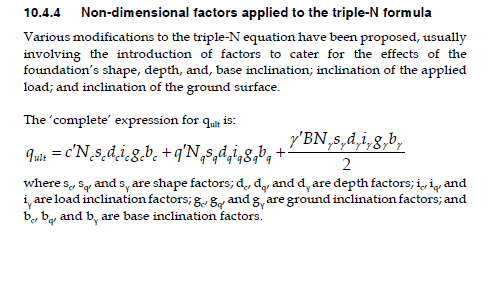Navigation
Install the app
How to install the app on iOS
Follow along with the video below to see how to install our site as a web app on your home screen.
Note: This feature may not be available in some browsers.
More options
Style variation
-
Congratulations TugboatEng on being selected by the Eng-Tips community for having the most helpful posts in the forums last week. Way to Go!
You are using an out of date browser. It may not display this or other websites correctly.
You should upgrade or use an alternative browser.
You should upgrade or use an alternative browser.
Bearing capacity of shallow foundation for both horizontal and vertical load simultaneously 1
- Thread starter gamidi67
- Start date
- Status
- Not open for further replies.
The inclination factors are dependent on the ratio H/Hmax, so you'll also need to know how to calculate Hmax. That is basically the shear resistance along the base area. You can legitimately add some passive earth pressure if you have a skirted foundation too.
-
1
- #5
I would transform the horizontal load to a moment (M= H x Df, I am assuming the horizontal load acting at ground level. Df is the depth of the footing embedment) and check eccentricity and that the maximum acting bearing pressure does not exceed the allowable bearing capacity/pressure.
The approaches above which suggest checking vertical/moment and horizontal capacities separately will not provide reliable results under combined loading as those checks would provide the maximum capacity under just vertical or just horizontal loading. Shallow foundations have their vertical, horizontal, moment and torsional (VHMT) reactions all coupled; that's what defines them as shallow foundations. As such, you cannot reliably check capacity under combined VHMT loading without considering the effect of the other capacity components.
Applied M will affect the V capacity (i.e. effective area concept). T can be considered as an additional horizontal load/reduction to the H part of the capacity envelope. The remaining VH envelope is curved - not rectangular - which shows interaction between the V and H components. If you have combined loading, you need to check all of the capacities together.
Incidentally, for drained conditions, the VH envelope is defined by H/V (rather than H/Hmax) in some standards. Also, some standards recommend a drained sliding line to intercept the capacity envelope.
Applied M will affect the V capacity (i.e. effective area concept). T can be considered as an additional horizontal load/reduction to the H part of the capacity envelope. The remaining VH envelope is curved - not rectangular - which shows interaction between the V and H components. If you have combined loading, you need to check all of the capacities together.
Incidentally, for drained conditions, the VH envelope is defined by H/V (rather than H/Hmax) in some standards. Also, some standards recommend a drained sliding line to intercept the capacity envelope.
- Status
- Not open for further replies.
Similar threads
- Locked
- Solved
- Replies
- 2
- Views
- 3K
- Replies
- 0
- Views
- 6K
- Locked
- Question
- Replies
- 3
- Views
- 5K
- Replies
- 6
- Views
- 10K
- Locked
- Question
- Replies
- 2
- Views
- 1K

